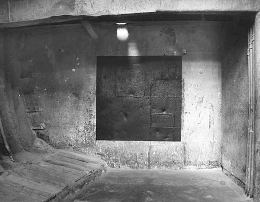C. P. Cavafy
Jannis Kounellis
|
So she went into the ship, going towards that "giving" C. P. Cavafy |
|
|
|
I want the return of poetry by all means available: through practice, observation, solitude; through language, image and insurrection. Jannis Kounellis |
The idea of an exhibition on shipboard captures the imagination. An artist and his work in the hold of a vessel: what does that signify? Johan in the belly of a whale?
It all begun in 1969, with a conceptual framework. A photograph, taken at sea, off the port of Naples: Kounellis sailing a boat, a strange Ulysses -striving to give shape and form to a strikingly austere visual language- and, with him, the sea itself. It was an embodiment of the creative impulse, bestowing on imagination the particular form that we call Art.

|
| Untitled, Venice 1974 |
In the 1960s, Kounellis extended the bounds of art into an almost theatrical space, where actors -both human and animal- created visual, scenic images.
The dialogue with the sea assumed another dimension in a barge on the Guide canal, during the 1974 Venice Biennale. Here the barge served as the setting for mystic, ceremonial acts, performed in the wan light of an oil lamp. It created an intensely hermetic, poetic environment, conceived as "a point where gods and men share the same interests". (Kounellis)
In the 1970s, adopting a metaphorical, almost mystical stance, Kounellis devised complex installations and actions that articulated powerful poetic, musical and historical memories.

|
| Untitled, 1979 |
There followed a series of works involving the theme of the ship.
In 1978 there was a model sailing ship on a pile of coal sacks; in 1980, the mast and sails of a raft, in front of a wall bearing traces of fire. In both works, the heterogeneous ingredients were linked and related by a sense of unendurable tension.
In his work of the 1980s, Kounellis embarked on a dialectic process that operating between sculpture and painting, attempted to reveal the codes of a hidden world; codes that relate to age - old myths and the very roots of human existence.
This process culminates in Albatros, his environment for the Metropolis exhibition in Berlin in 1991: a large, old boat, cut into pieces and displayed in the gallery of a Neo-classical museum, this marked an almost provocative contradiction. The protean quality of the work was confirmed by the faded name on the prow. Albatros stands for a legendary bird; a small boat from the port of Ostia, and a poem by Beaudelaire. In a work charged with extraordinary energy, Kounellis had achieved conceptual purity while setting a simultaneous course towards dream and memory.
That course was to lead him to the Venice Biennale of 1993, where he showed an ethereal, poetic work: his environment made up of sails from old Venetian vessels. This was the last port of call, en route to the work now stowed on board the MV IONION.

|
A ship's hold is neither a museum nor a gallery. It is a dark womb that safeguards the work and lends it an archetypal dimension. It is, moreover, a space that invites the imagination to approach another reality. With its compact, seemingly anarchic and "disorderly" positioning of works on diferrent levels, it creates a highly charged, poetic display of a complex artistic intention.
A distinct "theatrical" dimension serves to define the experience offered by the hold as an exhibition space, while simultaneously negating the idea of a museum.
The ship that lies moored in Piraeus -the port from which Kounellis set out some fourty years ago- is ready to sail on a poetic voyage into History and Art, which is also a voyage through European literature, a thread, like Ariadne's, that leads from Homer to Cavafy and from Rimbaud to Joyce.
Kounellis's work offers questions rather than answers: questions about space, about violence, about the functions of memory, about relations within society and the historical framework that defines them.